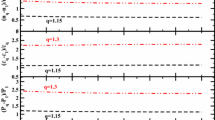Summary
We investigate the Poincaré covariance of the Hamiltonian of aN-fermion system, in which the two-body interaction is produced by the exchange of a massless vector boson with a nonconstant form factor at vertices. The relativistic separation of center-of-mass and internal-motion variables is performed by exploiting an approach developed some years ago by Krajcik and Foldy. It is shown that, in order to ensure that theN-fermion Hamiltonian (expanded up to the order 1/c 2) is the time-translation generator of the Poincaré algebra, one requires a correct treatment of the form factor at the order considered, and, for noncommuting particle «charges», the inclusion in the potential of three-body terms, whose expression is explicitly derived. A preliminary analysis of the effect of such terms is given for baryons and deuterium in the framework of the constituent quark model.
Riassunto
Si esamina la covarianza sotto il gruppo di Poincaré dell’hamiltoniana di un sistema diN fermioni, nel quale l’interazione a due corpi è prodotta dallo scambio di un bosone vettoriale di massa nulla, con un fattore di forma non costante ai vertici. La separazione relativistica delle variabili del baricentro e di quelle del moto interno è effettuata tramite un metodo sviluppato alcuni anni addietro da Krajcik e Foldy. Si dimostra che, affinché l’hamiltoniana aN fermioni (sviluppata fino all’ordine 1/c 2) sia effettivamente il generatore delle traslazioni temporali dell’algebra di Poincaré, è necessario trattare correttamente il fattore di forma all’ordine considerato, e, per «cariche» delle particelle non commutanti, includere nel potenziale termini a tre corpi la cui espressione è ricavata esplicitamente. Viene fornita un’analisi preliminare dell’effetto di tali termini per i barioni e per il deuterio nell’ambito del modello a quark costituenti.
Резюме
Мы исследуем ковариантность Пуанкаре Гамильтониана системыN-фермионов, в котором двух-частичное взаимодействие обусловлено обменом безмассовым векторным бозоном с непостоянным форм-фактором в вершинах. Проводится релятивистское разделение переменных центра масс и внутреннего движения, используя подход, развитый несколько лет назад Крайциком и Фолди. Для того, чтобы Гамильтониан системыN-фермионов представлял генератор трансляции времени для алгебры Пуанкаре, необходимо корректное рассмотрение форм-фактора и, для некоммутирующих «зарядов» частиц, включение в потенциал трех-частичных членов, для которых выводится явное выражение. Проводится предварительный анализ таких членов для барионов и дейтерия в рамках составной модели кварков.
Similar content being viewed by others
References
J. P. Lipkin:Phys. Lett. B,74, 399 (1978);Phys. Rev. Lett.,41, 1629 (1978);Nucl. Phys. B,155, 104 (1979);N. Isgur andG. Karl:Phys. Lett. B,74, 353 (1978);Phys. Rev. D,18, 4187 (1978);19, 2653 (1979);20, 1191 (1979);21, 3175 (1980);L. A. Copley, N. Isgur andG. Karl:Phys. Rev. D,20, 768 (1979);R. Koniuk andN. Isgur:Phys. Rev. Lett.,44, 845 (1980);Phys. Rev. D,21, 1868 (1980);23, 818 (1981);S. Godfrey andN. Isgur:Phys. Rev. D,32, 189 (1985);S. Capstick andN. Isgur:Phys. Rev. D,34, 2809 (1986). For reviews, seee.g. N. Isgur: inThe New Aspects of Subnuclear Physics, edited byA. Zichichi (Plenum, New York, N. Y., 1980), p. 107;R. Mignani andD. Prosperi:Constituent quark models for hadrons and nuclei, inProceedings of the First International Course on Condensed Matter, Bogotà, July 7–18, 1986, edited byD. Prosperi, S. Rosati andG. Violini (World Scientific, Singapore, 1988).
See,e.g., Quarks and Nuclear Forces, edited byD. Fries andB. Zeitnitz (Springer-Verlag, Berlin, 1982);Quarks and Nuclear Structure, edited byK. Blender (Springer-Verlag, Berlin, 1984);Theoretical and Experimental Investigations of Hadronic Few-Body Systems, edited byC. Ciofi degli Atti, O. Benhar, E. Pace andG. Salmè (Springer-Verlag, Wien, 1986);Particles and Nuclei, PANIC ’87, edited byS. Homme, M. Morita, K. Nakai andT. Yamazaki (North-Holland, Amsterdam, 1988).
For experimental and theoretical reviews, seeInterpretation of the EMC effect, inParticles and Nuclei (last ref. [2]), p. 385c.
K. Maltman andN. Isgur:Phys. Rev. Lett.,50, 1827 (1983);Phys. Rev. D,29, 952 (1984);S. J. Brodsky:Nucl. Phys. A,416, 3c (1984);Commun. Nucl. Part. Phys.,12, 213 (1984);L. A. Kondratyuk andM. Z. Shmatikov:Z. Phys. A,321, 217 (1985);M. Sato andS. A. Coon:Phys. Rev. C,33, 1062 (1985).
D. A. Liberman:Phys. Rev. D,16, 1572 (1977);C. De Tar:Phys. Rev. D,17, 302, 323 (1978);M. Harvey:Nucl. Phys. A,424, 428 (1984). For the so-calledP-matrix approach, seeR. L. Jaffe andF. E. Low:Phys. Rev. D,19, 2105 (1979). For quark-exchange models, see,e.g.,F. Lenz: inNuclear Chromodynamics, edited byS. J. Brodsky andE. J. Moniz (World Scientific, Singapore, 1986).
K. Bleuler, H. Hofestädt, S. Mark andH. R. Petry:Z. Naturforsch. A,38, 705 (1983);K. Bleuler: inPerspectives in Nuclear Physics (World Scientific, Singapore, 1984), p. 455;H. R. Petry, H. Hofestädt, S. Mark, K. Bleuler, H. Bohr andK. S. Narain:Phys. Lett. B,159, 363 (1985).
H. J. Lipkin:Nucl. Phys. A,478, 307c (1988).
See,e.g.,M. Oka andK. Yazaki:Prog. Theor. Phys.,66, 556, 572 (1981);Nucl. Phys. A,402, 477 (1983);J. E. F. T. Ribeiro:Z. Phys. C,5, 27 (1980);A. Faessler, F. Fernandez, G. Lubeck andM. Shimizu:Nucl. Phys. A,402, 555 (1983);K. Suzuki andK. T. Hecht:Phys. Rev. C,27, 299 (1983);28, 1458 (1983);29, 1586 (1984);G. Spitz andW. Schmidt:Few Body Systems,1, 37 (1986);M. Wakamatsu, R. Yamamoto andY. Yamaguchi:Phys. Lett. B,164, 148, 153 (1984).
A. De Rujula, H. Georgi andS. L. Glashow:Phys. Rev. D,12, 147 (1975).
The novel physical features arising in multiquark systems withN>3 are discussed byH. J. Lipkin inIntersections between Particle and Nuclear Physics, edited byD. G. Geesaman,AIP Conference Proc., No. 150 (Lake Louise, Canada, 1988), p. 657.
R. A. Krajcik andL. L. Foldy:Phys. Rev. D,10, 1777 (1974).
F. Coester: inThe Three-Body Force in the Three-Nucleon System, edited byB. L. Berman andB. F. Gibson (Springer-Verlag, Berlin, 1987), p. 472.
L. Foldy:Phys. Rev.,122, 275 (1961).
See,e.g.,F. Coester:Helv. Phys. Acta,38, 7 (1965).
M. H. Storm andA. Watt:Nucl. Phys. A,408, 397 (1983).
Th. Pfenninger, A. Faessler andK. Bräuer:Nucl. Phys. A,466, 495 (1987).
See,e.g.,A. W. Thomas: p. 76/88 Dept. Theor. Phys. Oxford Univ. (1988), and references therein.
S. I. Bityukov et al.:Phys. Lett. B,188, 383 (1987);M. Boutemeur: inHadrons, Quarks and Gluons, Proceedings of the XXII Rencontre de Moriond (to appear).
Author information
Authors and Affiliations
Additional information
Переведено редакцией.
Rights and permissions
About this article
Cite this article
De Sanctis, M., Mignani, R. & Prosperi, D. Covariance properties of a multifermion Hamiltonian with pairwise, massless vector-boson exchange. Nuov Cim A 102, 1671–1700 (1989). https://doi.org/10.1007/BF02825159
Received:
Published:
Issue Date:
DOI: https://doi.org/10.1007/BF02825159



